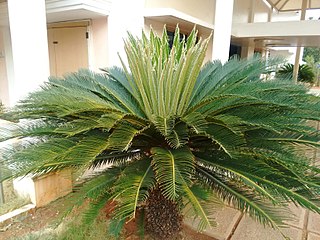
The Preuss's monkey, also known as Preuss's guenon, is a diurnal primate that lives terrestrially in mountainous forests of eastern Nigeria, western Cameroon and Bioko in Equatorial Guinea. It was formerly classified as a subspecies of the L'Hoest's monkey.

Cycas is a genus of cycad, and the only genus in the family Cycadaceae. About 113 species are accepted, which are native to the Asia-Pacific, East Africa and Madagascar. Cycas circinalis, a species endemic to India, was the first cycad species to be described in western literature, and is the type species of the genus. The best-known Cycas species is Cycas revoluta.

Caridina is a genus of freshwater atyid shrimp. They are widely found in tropical or subtropical water in Asia, Oceania and Africa. They are filter-feeders and omnivorous scavengers. They range from 0.9–9.8 mm to 1.2–7.4 mm in carapace length.

Aneuraceae is a family of thallose liverworts in the order Metzgeriales. Most species are very small with narrow, branching thalli.

Pleosporaceae is a family of sac fungi. The taxonomic relationship of this family to associated genera is still not determined.

The Corallinaceae are one of the two extant Coralline families of red algae; they are differentiated from the morphologically similar Sporolithaceae by their formation of grouped sporangial chambers, clustered into sori. The Corallinoideae is monophyletic; the other subfamilies form another monophyletic group.

Pucciniastrum is a genus of Basidiomycota fungi. Pucciniastrum species, like all rust fungi, are obligate plant parasites.
Massaria is a genus of fungi in the family Massariaceae.
Cryptothallus is a previously recognized genus of liverworts in the family Aneuraceae. The plants are small, and are white to pale green as a result of lacking chlorophyll. This feature led to the creation of a separate genus. The morphology of species assigned to Cryptothallus is very similar to that of Aneura. As a result, Karen Renzaglia in 1982 suggested that the only species then placed in the genus, Cryptothallus mirabilis, may be considered "merely as an achlorophyllous species of Aneura." Wickett and Goffinet argued the same position on the basis of sequences of nuclear, mitochondrial, and plastid DNA, and moved Cryptothallus mirabilis to Aneura. A 2010 molecular phylogenetic study confirmed the position of Cryptothallus within Aneura. This was accepted in the 2016 world checklist of hornworts and liverworts.
Graphium is a genus of fungi in the family Microascaceae. Many species are known as plant pathogens. Graphium belongs to the group hyphomycetes and has about 20 species. They are found in soil, plant debris, woody substrate, manure, and polluted water. The sporulating structures of Graphium form synnema, which are a gathering of conidiophores into a sort of flower bouquet. Graphium spp. are recognized by their distinctive, erect, black synnemata, each bearing a single, terminal, ball of one-celled, hyaline conidia produced from annellides.
Monacrosporium is a genus of fungi in the family Orbiliaceae. There are 53 species.

Bauerago is a genus of fungi found in the family Microbotryaceae. It contained 9 species before being reduced to 5 species.

Cordana is an ascomycete fungus genus. In 2020, it was placed within the monotypic family of Cordanaceae, and within the order Coniochaetales.
Gliocladium is an asexual fungal genus in the Hypocreaceae. Certain other species including Gliocladium virens were recently transferred to the genus Trichoderma and G. roseum became Clonostachys rosea f. rosea in the Bionectriaceae. Gliocladium is a mitosporic, filamentous fungus. Species of Gliocladium rarely produce a sexual state. Most pathogenic, disease-causing fungi in humans are mitosporic like Gliocladium. Gliocladium is filamentous; it grows tubular, elongated, and thread-like. It can be considered a contaminant.

Isaria is a genus of fungi mostly in the order Hypocreales and family Clavicipitaceae, or by some authorities the Cordycipitaceae. It includes a large number of entomopathogenic species, some of them exploited as biopesticides : often previously assigned to the genus Paecilomyces.

Ampelomyces is a genus of lichenicolous fungi in the family Phaeosphaeriaceae. The type species is Ampelomyces quisqualis which was circumscribed by Italian botanist Vincenzo de Cesati in Klotzsch, Bot. Ztg. vol.10 on page 301 in 1852.
Clonostachys is a genus of fungi in the order Hypocreales and family Bionectriaceae. Clonostachys rosea f. rosea is of interest as a biological pest control agent.

Lichenoconium is a genus of fungi belonging to the family Lichenoconiaceae.
Botryosporium is a genus of fungi belonging to the order Hypocreales, family unknown.
Spinosipella is a genus of small carnivorous bivalves in the family Verticordiidae.












